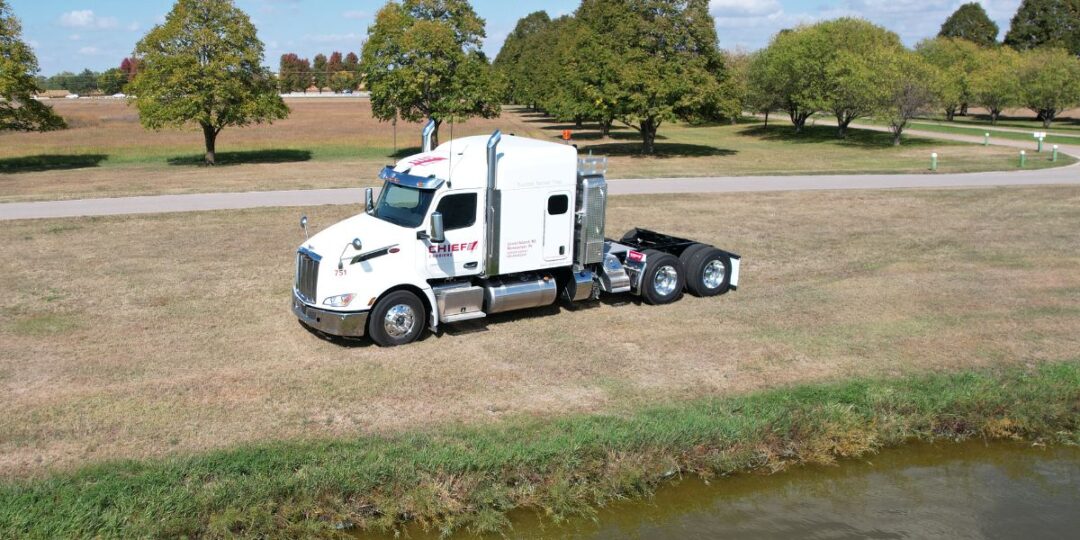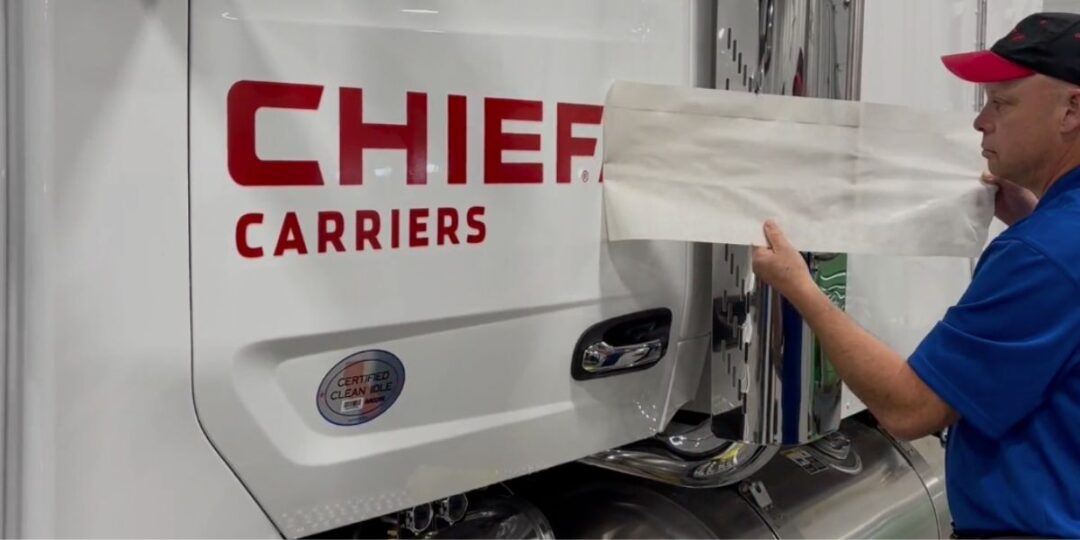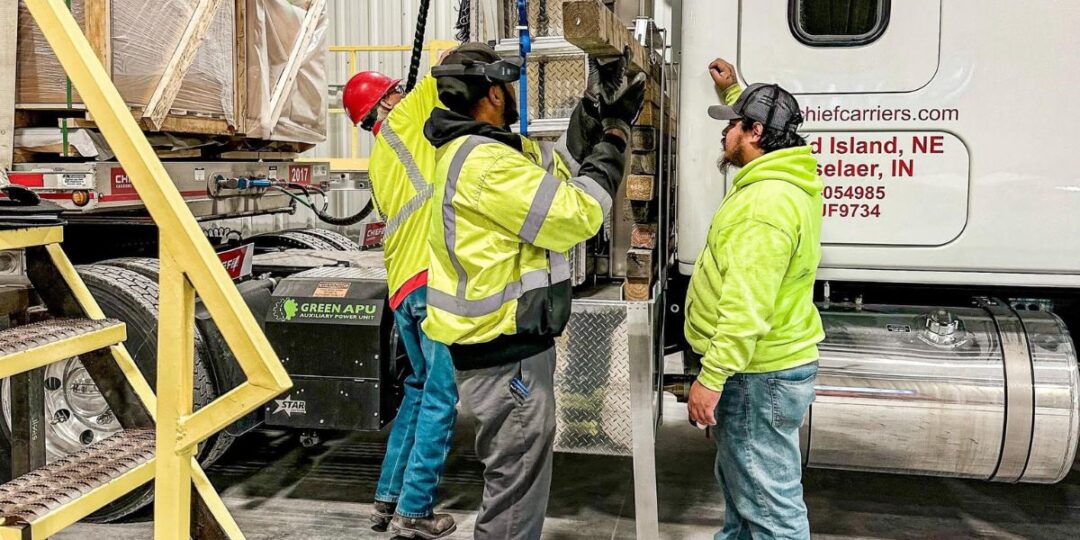Truck Driver Safety Checklist in Spanish
The rigors of the open road demand not only skill and focus but also a deep Truck Driver Safety checklist from every truck driver.
For our Spanish-speaking community behind the wheel, staying informed and prepared is key to navigating the vast highways safely and efficiently.
This blog post dives into the essentials of truck driver safety, keenly aware that by sharing knowledge, we’re caring for individual drivers and building a stronger trucking community.
Here, we explore this world, highlighting Chief Carriers recommendations on an accurate truck driver safety checklist.

Why Truck Driver Safety Matters
Safety on the road is the foundation of a thriving trucking industry. It ensures the well-being of the drivers and the public and sustains the flow of goods that communities depend on.
For Spanish-speaking drivers, understanding safety in one’s native language removes barriers, allowing vital practices to be easily understood and applied.
To further support our Spanish-speaking truck drivers in their mission to stay safe on the road, here is a critical driver safety checklist, that everyone should follow:
- Stay Alert: Long hours on the road can lead to fatigue. Take regular breaks, stay hydrated, and ensure you’re well-rested before driving.
- Adhere to Speed Limits: Speeding increases the risk of accidents. Always follow speed limits and adjust your speed according to road conditions.
- Secure Your Load: Properly securing your load not only complies with safety regulations but also prevents accidents caused by shifting or falling cargo.
- Use Seat Belts: Always wear a seat belt while driving. It’s your best defense in the event of a crash.
- Avoid Distractions: Keep your focus on the road. Avoid using mobile phones or other devices that can divert your attention away from driving.
- Be Aware of Weather Conditions: Adverse weather can significantly impact driving conditions. Stay informed about the weather along your route and be prepared to adjust your driving accordingly.
- Know Your Route: Familiarize yourself with your route before you depart. Knowing the route can help you anticipate and avoid potential hazards.

Pre-Departure Truck Inspection Checklist
Vehicle Inspection
Before setting off, a thorough vehicle inspection with a driver safety checklist can prevent unforeseen issues. Check the brakes, tires, lights, and windshield wipers to ensure your truck is roadworthy.
English
- Tire Pressure and Condition: Verify that all tires are properly inflated and free from excessive wear or damage.
- Lights and Signals: Confirm that headlights, brake lights, turn signals, and emergency flashers are functioning correctly.
- Windshield Wipers: Make sure the wipers are in good condition and the wiper fluid is full.
- Mirrors: Adjust all mirrors to ensure maximum visibility without blind spots.
- Load Security: Double-check that the cargo is properly secured and balanced according to safety regulations.
- Emergency Kit: Verify that your truck is equipped with a first aid kit, fire extinguisher, warning triangles, and any other required emergency equipment.
- Documentation: Ensure all necessary documents, including your driver’s license, vehicle registration, and insurance, are up to date and accessible.
Spanish list
- Presión y condición de los neumáticos: Verifique que todos los neumáticos estén correctamente inflados y libres de desgaste o daños excesivos.
- Luces y señales: confirme que los faros, las luces de freno, las señales de giro y las luces intermitentes de emergencia estén funcionando correctamente.
- Limpiaparabrisas: asegúrese de que los limpiaparabrisas estén en buenas condiciones y que el líquido del limpiaparabrisas esté lleno.
- Espejos: ajuste todos los espejos para garantizar la máxima visibilidad sin puntos ciegos.
- Seguridad de la carga: Verifique nuevamente que la carga esté correctamente asegurada y equilibrada de acuerdo con las normas de seguridad.
- Botiquín de emergencia: Verifique que su camión esté equipado con un botiquín de primeros auxilios, extintor de incendios, triángulos de advertencia y cualquier otro equipo de emergencia requerido.
- Documentación: asegúrese de que todos los documentos necesarios, incluida su licencia de conducir, registro del vehículo y seguro, estén actualizados y sean accesibles.

Ultimate Truck Driver Safety Checklist for Cargo Inspection
Secure cargo is safe cargo. With this cargo-oriented driver safety checklist, verify that your load is properly fastened and balanced to prevent shifts that could lead to accidents.
English
- Load Stability: Ensure that the cargo is evenly distributed and stable, with heavier items at the bottom and lighter items on top where applicable.
- Securement Devices: Check that all chains, straps, and binders are in good condition, free from wear or damage, and are of appropriate strength for the load they are securing.
- Anchoring Points: Inspect anchoring points on both the cargo and the vehicle to ensure they are robust and capable of holding the load securely throughout the trip.
- Edge Protection: Use edge protectors where necessary to prevent straps from cutting into the cargo.
- Tarpaulins: If using tarpaulins, ensure they are properly fitted and secure, without any tears or loose parts that could catch the wind.
- Prohibited Overloading: Confirm that the cargo does not exceed the truck’s loading capacity and is within legal limits.
- Special Requirements for Hazardous Materials: Verify that any hazardous materials are properly labeled and secured in accordance with regulations.
- Freight Paperwork: Check that you have the correct paperwork for your cargo, which may be required during transport or inspection points.
- Final Walkaround: Perform a final walkaround of the vehicle to check that nothing has been overlooked and that all cargo is secure.
Spanish
- Estabilidad de la carga: asegúrese de que la carga esté distribuida uniformemente y sea estable, con los artículos más pesados en la parte inferior y los más livianos en la parte superior, cuando corresponda.
- Dispositivos de sujeción: Verifique que todas las cadenas, correas y ataduras estén en buenas condiciones, libres de desgaste o daños y que tengan la resistencia adecuada para la carga que están asegurando.
- Puntos de anclaje: Inspeccionar los puntos de anclaje tanto de la carga como del vehículo para asegurarse de que sean robustos y capaces de sostener la carga de forma segura durante todo el viaje.
- Protección de bordes: use protectores de bordes cuando sea necesario para evitar que las correas corten la carga.
- Lonas: En caso de utilizar lonas, asegúrese de que estén bien colocadas y aseguradas, sin roturas ni partes sueltas que puedan atrapar el viento.
- Sobrecarga Prohibida: Confirmar que la carga no excede la capacidad de carga del camión y se encuentra dentro de los límites legales.
- Requisitos especiales para materiales peligrosos: Verifique que todos los materiales peligrosos estén correctamente etiquetados y asegurados de acuerdo con las regulaciones.
- Trámites de Carga: Verifique que cuente con la documentación correcta para su carga, la cual puede ser requerida durante el transporte o puntos de inspección.
- Recorrido final: realice un recorrido final del vehículo para comprobar que no se haya pasado nada por alto y que toda la carga esté segura.

On-The-Road Safety Practices
Defensive Driving Techniques
The unpredictability of the road necessitates defensive driving. Always anticipate the actions of other road users and keep a safe distance — patience goes a long way in preventing accidents.
- Stay Vigilant: Defensive driving demands constant vigilance.
Pay attention to the behavior of other drivers and pedestrians, as well as animals that may enter the roadway.
- Minimize Distractions: Avoid using your phone, eating, or any activity that takes your focus away from driving.
If you must attend to something important, find a safe place to pull over before doing so.
- Maintain a Safe Following Distance: Keeping a safe distance between your vehicle and the one ahead gives you more time to react to sudden stops or emergencies.
A general rule is to maintain at least a three-second gap, which should be increased depending on weather conditions and the weight of your cargo.
- Expect the Unexpected: Anticipate possible scenarios that could unfold around you.
By expecting the unexpected, you can strategize your actions in advance, reducing the likelihood of panic-induced mistakes.
- Use Your Signals: Communication is key in defensive driving.
Always use your turn signals well in advance of making a turn or changing lanes.
- Adapt to Weather and Road Conditions: Adjust your speed and driving style to suit the conditions, ensuring you have control of your vehicle at all times.
- Understand Your Vehicle’s Capabilities: Understand how your truck responds in different situations to fully leverage your vehicle’s capabilities for safe driving.
- Practice Patience and Courtesy: Always practice patience and courtesy towards other road users.
Allow others to merge, avoid blocking intersections, and be forgiving of others’ mistakes.
Truck Fatigue Management
Long hours behind the wheel can lead to fatigue, which is a major cause of accidents. Take regular breaks, adhere to driving hour regulations, and recognize when it’s time to rest.
- Recognize Signs of Fatigue: Awareness of the early signs of fatigue, such as frequent yawning, heavy eyes, and a lack of concentration, can help prevent accidents.
- Plan Your Trips with Rest in Mind: Before embarking on a long-haul trip, plan your route, including rest stops.
Strategic planning can significantly reduce the risk of fatigue-related incidents.
- Use Napping Effectively: Short, controlled naps of 20-30 minutes can significantly reduce fatigue and improve alertness.
- Maintain a Healthy Lifestyle: A healthy lifestyle can increase your stamina and energy levels, making it easier to manage the demands of long-haul driving.
- Stay Hydrated and Eat Healthily on the Road: Drink plenty of water and choose healthy, light meals or snacks that release energy slowly to help maintain alertness.
- Limit Consumption of Stimulants: While caffeine can temporarily increase alertness, reliance on it or other stimulants can lead to a cycle of highs and lows; use them sparingly and understand their effects on your body.
- Leverage Technology for Better Sleep Management: Take advantage of apps and devices designed to promote better sleep patterns and relaxation techniques.
- Professional Support: If you’re consistently struggling with fatigue, it may be beneficial to seek professional medical advice.

Emergency Preparedness
Being well-prepared for emergencies is crucial for ensuring the safety of truck drivers and other road users.
Always have a readily accessible list of emergency contacts, including dispatch numbers, road assistance, medical facilities along the route, and family contacts. Ensure this list is updated regularly.
A well-stocked first aid kit is indispensable. It should include items such as bandages, antiseptic wipes, adhesive tape, scissors, pain relievers, and gloves.
Regular checks are necessary to replenish used or expired items.
Knowledge of Emergency Truck Maintenance Checklist Procedures
Familiarize yourself with emergency procedures. Whether it’s responding to a mechanical failure or a road accident, knowing what to do can make a crucial difference.
- Mechanical Breakdowns
In the event of a mechanical failure, safely maneuver your vehicle to the side of the road, away from traffic.
Use warning triangles or flares to alert other road users of your presence. Contact roadside assistance and wait for professional help inside your vehicle if it’s safe to do so.
- Accident Response
If involved in a road accident, prioritize safety by turning on your hazard lights and securing the area with warning signs to prevent further incidents.
Check for injuries and call emergency services if needed. Exchange necessary information with other parties involved and document the scene with photos for insurance purposes.
- Fire Emergencies
Should a fire occur, evacuate the vehicle immediately and move to a safe distance.
Attempt to extinguish the fire only if it’s small and you’re trained on how to use a fire extinguisher safely. Always call the fire department, as vehicle fires can escalate quickly.
- Hazardous Material Spills
Drivers carrying hazardous materials must follow specific procedures in the event of a spill.
This includes securing the area, using appropriate protective gear, and notifying emergency services along with the designated emergency response number provided for the hazardous material.
- Medical Emergencies
If you or someone else experiences a medical emergency, pull over safely if you’re driving.
Use a first aid kit to provide initial assistance and call emergency services for medical help. Having basic first aid training can be invaluable in such circumstances.
- Severe Weather Conditions
Being caught in severe weather, such as heavy snow or thunderstorms, requires immediate action.
Find a safe location to wait out the weather or seek shelter if conditions are dangerous. Keep emergency supplies, such as blankets and water, in your vehicle.
- Security Threats
In case of a security threat or if you feel unsafe due to suspicious activity, stay inside your vehicle with doors locked and windows up.
Contact law enforcement for assistance. Always be mindful of your surroundings and avoid parking in isolated or poorly lit areas.

Truck Driver Safety Checklist and Communication Protocols
Always keep communication lines open. In the event of an emergency, being able to quickly reach out for help is essential.
Effective communication protocols are the backbone of ensuring prompt response and support during emergencies or unexpected situations on the road.
- Regular Check-Ins
Drivers should establish regular check-in times with their dispatch center.
This ensures that the dispatch team is always aware of the driver’s location and status, enabling quick mobilization of assistance if the driver fails to check in as expected.
- Advanced GPS and Telematics
Utilizing advanced GPS systems and telematics not only aids in navigation but also allows for real-time tracking of vehicles by the dispatch center.
In emergencies, precise locations can be instantly provided to response teams, significantly reducing response times.
- Emergency Signal Devices
In addition to standard communication tools, having an emergency signal device can be a lifesaver, particularly in areas with poor cell reception.
Devices that can send out a distress signal or an SOS to authorities with the push of a button should be considered essential gear.
- Training on Communication Protocols
Regular training on the use of communication devices and protocols is crucial.
Drivers should be comfortable and familiar with all communication tools and procedures, including how to properly report an incident, who to contact for different types of emergencies, and how to maintain communication in challenging environments.
- Backup Communication Plans
Always have a backup communication plan in place. Technology can fail, and having alternative means of communication can prevent a bad situation from worsening.
This might include satellite phones as a backup to cell phones or having predefined signals for use with fellow drivers.
Truck Driving Regulatory Compliance
Understanding and Following Transportation Regulations
Stay up-to-date with transportation regulations, including those specific to the regions you traverse. Compliance is not just about legality; it’s about safety.
- Stay Informed on Changes: It is essential for drivers and trucking companies to stay informed about the latest updates.
- Record Keeping and Documentation: This includes maintaining accurate logs of driving hours, vehicle maintenance records, and cargo details.
- Safety Inspections and Audits: Regular vehicle inspections and audits are not only regulatory requirements but are pivotal for ensuring the safety of the vehicle, the driver, and other road users.
- Hazardous Materials Handling: Ensure you understand the classification of hazardous materials you are carrying and comply with all handling, packaging, and documentation standards.
Importance of Regular Training and Certification
Continuous learning keeps you sharp and safe. Engage in regular training sessions and renew your certifications as needed.
- Cargo Securement: Unsecured loads can shift or fall, leading to accidents and serious damage.
Adhere to regulations and training on proper cargo securement to avoid potential hazards.
- Driver Health and Wellness: Ensure drivers are in good physical and mental health through regular health checks, proper rest and nutrition, and access to support services.
- Driver Training and Certification: Consider enrolling in training programs that focus on specific areas, such as hazardous materials handling, defensive driving techniques, or first aid.
Truck Driver Safety Checklist Considerations for Spanish-Speaking Drivers
Addressing safety with cultural sensitivity makes the message resonate more deeply.
For Spanish-speaking drivers, having access to materials and training in Spanish fosters an inclusive environment where safety comes first.
To our Spanish-speaking compatriots, your role in the tapestry of the trucking industry is invaluable. By adhering to these safety practices, you contribute not only to your well-being but to the strength and safety of the community at large.

Remember, Truck Driver Safety
It’s our shared commitment to making every journey safe. Here’s to maintaining vigilance, sharing knowledge, and driving with care, knowing that together, we make the road safer for everyone.
Commercial Truck Driving Jobs Opens Up New Career Opportunities
Beyond truck driving, commercial licenses open the door to numerous driving-related occupations. Whether it’s a role in logistics management, training new drivers, or even venturing into entrepreneurship within the transportation sector, the skills acquired through commercial driving are both valuable and transferable.
With determination, the right training, and a company like Chief Carriers, the journey ahead is promising.
For opportunities in truck driving jobs and to learn more about driver safety checklists, connecting with Chief Carriers offers a wealth of resources and support tailored for our community.
Contact us today and start your journey.

